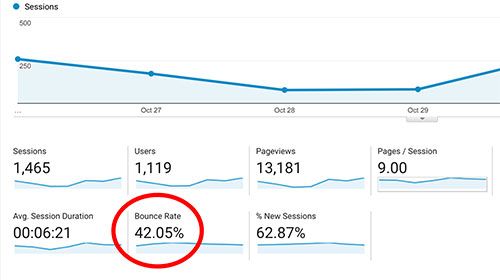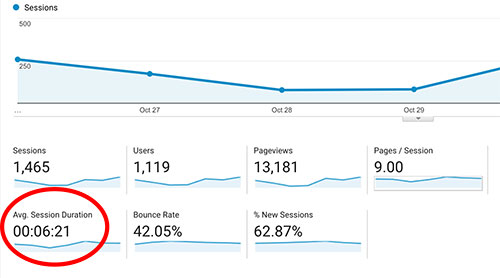By Focusing On These 2 Simple Website Metrics
Analytics | Bounce Rate | Time On Page | Share on Facebook Share on Twitter
Google And Your Visitors Will Be Digitally Delighted!
You’ve got a new website. You’ve spent a ton of money and time on. It finally launched and you’re done, right? Well… Wrong.
Now it’s time to figure out if your website is actually working for you. So you crack open good ol’ Google Analytics and dive into the sea of marketing metrics. With a million different variables, graphs and diagrams, it’s easy to focus on something like site traffic, verify traffic is up over last month and call it a day. I mean, traffic’s up right? So what’s the big deal?
Sorry, it’s just not that simple. But hey, don’t worry! You’re not alone. Many business owners stop there. Hell, your competitors are most likely stopping there and giving themselves a nice digital pat on the back because their traffic is up 4% over last month! Go TEAM! But in reality, this is probably bad news for them and good news for you!
Why?
Because while they are celebrating a 4% traffic increase at Applebee’s “bottomless appetizers” happy hour, you’re reading this blog and are dedicated to upping your digital marketing game! Feel free to pat yourself on the back, you’ve earned it! That is, after you finish this blog…of course
Ok, so you checked the site traffic and noticed your getting 10,000 (or 1,000, it’s all relative) visitors every month and think, “My website is amazing!”. But yet your sales haven’t increased and your lead funnel is drying up. Wait…all those visitors aren’t actually buying anything and your pipeline is looking pretty empty? But doesn’t more traffic mean more sales? More delighted customers?
Just because you have a ton of visitors doesn’t mean your website is functioning well. In fact, getting thousands of visitors who don’t stay long on your site can actually hurt your SERP rankings.
But before we get into SERP rankings factors, let’s talk about the real reason you came here; to find the two metrics you need in order to understand how your website is actually doing and how you can make proper growth adjustments.
But Your Visitors Just Got Here, So Why Are They Leaving?
Well, before panic sets in remember to first look at these two metrics – bounce rate and time on page.
Let’s start with bounce rate. It’s simply the number of people who come to your site, look at one page and leave.
To Google, this is a huge red flag. It means that people are looking to your site for answers and when they get there, they’re not finding any, so they leave – or bounce – to another site. Google sees this as proof that your site doesn’t have enough quality content to keep the user engaged which forces Google to lower your website in the search rankings, making it even harder for people to find you.
Think of it like calling someone, talking for a few seconds and then hanging up without saying goodbye. How rude!
Instead you want to be more like Wikipedia. You go there to learn more about the Roman Empire. Next thing you know, you’ve spent 30 minutes, read 10 different authoritative entries and feel confident you’re ready to rock your book club’s discussion on “The Ides Of March” by Thornton Wilder.
Welcome – Now Please Stay Awhile
For businesses, you want to use your site to answer all the needs or “pains” your customers have. If you’re an HVAC company, your content can tell people how to replace their filters as well as other ways to troubleshoot HVAC problems on your own time. You want people to start building a relationship and trusting your expertise by reading your content. This trust will help you convert them into customers. How? There will come a time that you will not be able to make a repair but will feel confident that the company who has been guiding you all along will easily have a fix your problem. 
But like everything, there’s an exception to the bounce rate rule. If your customers are coming directly to a contact us page or other business offer, they may fill out the form or contact you and then bounce off the site. If your digital marketing team is savvy, they will ensure Google see’s these events as conversions not bounces. In the users eyes, since they’re setting up a meeting that will hopefully end in a sale, they don’t need to read your other content OR maybe they have already done that in a previous visit and now they’re ready to talk turkey.
You’re Really Going To Like What We Have To Say
The second key metric to track is time on page. This metric looks at how long a person spends on each page. It goes hand-in-hand with bounce rate because the longer they spend on each page, the more likely they are to find your content useful. Hopefully they’ll follow your links to other pages to learn more about your products or services.
Creating The Perfect Environment To… Make A Sale
OK – so what exactly do you want to see when you check out these two metrics?
It’s better to have 500 visitors with a 20% bounce rate who are spending 7 to 8 minutes on each page than to have 1,000 visitors with an 80% bounce rate spending just 30 seconds on your site.
In the first case, you’re getting 400 visitors that are clearly interested in what you’re selling. They’re much more likely to convert to customers and recommend you to their friends
In the second case, you’re looking at only 200 people who aren’t spending much time reading your content and probably won’t convert into customers and not recommend you to their friends.
Was It Something We Said?
Whether it’s poor content or a terrible user experience that’s driving up your bounce rate, you’re damaging your brand, ticking off potential customers and sending Google all kinds of red flags.
Your site needs to have good content from the homepage to the landing pages. Everything on your site needs to be focused on answering your customers’ pains with clear links to other pages to build their knowledge base while demonstrating that you’re the one who can help them.
While it’s easy to get bogged down in hundreds of website metrics, do yourself a favor and focus on just two – bounce rate and time on page for now.
These metrics will help you see if your site is working for you or if it needs attention pronto. If you find that you have a problem, don’t freak out. There are plenty of ways to turn your website into the revenue-generating tool of your dreams.
Click the link below for a free assessment of your websites performance. No strings attached.
October 26, 2017









